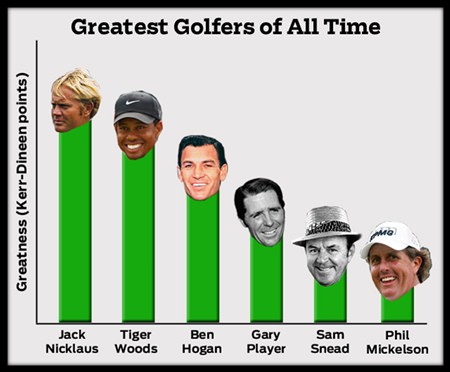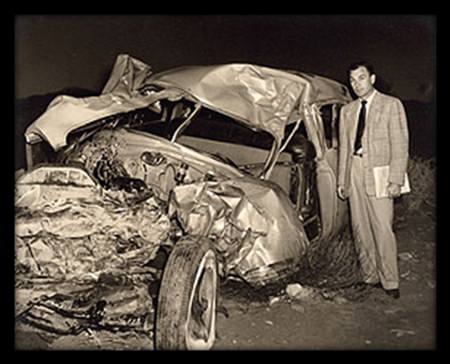The golfing media is constantly posing this question. The answer, at least with most analysts, will normally come down to one of three contenders; Jack Nicklaus – the most “winningest” golfer, Tiger Woods – owner of the most complete golf game, and Ben Hogan – the purest ball-striker the game has known. The passage of time tends to put older golfers in straw polls such as these at a disadvantage. This article will attempt to redress this imbalance.
It is nigh-on impossible to compare Hogan’s career with that of Nicklaus and Woods for two major reasons; WWII and a car accident. During the period 1940 – 1945, golf’s majors were curtailed. Hogan, who had turned professional in 1930, joined the US Army in 1943, meaning he had limited opportunities to compete when in his prime.
 The best golfers ever, according to the Kerr-Dineen points system.
The best golfers ever, according to the Kerr-Dineen points system.
Hogan was born at a similar time (1912) to Sam Snead and Byron Nelson – both acknowledged golfing greats of the last century. Unlike his two contemporaries, however, Hogan experienced a hard and traumatic upbringing. He was nine years old when his father committed suicide by shooting himself in the chest – some, including Hogan’s biographer, say he did it in front of his son – leaving his wife to bring up three children as best she could. The children had jobs from an early age.
His nine major championships tie him (with Gary Player) for fourth all-time, trailing only Jack Nicklaus (18), Tiger Woods (14) and Walter Hagen (11). Furthermore, he is one of only five golfers to have won all four major championships (the Masters Tournament, the Open Championship, the U.S. Open, and the PGA Championship), the other four being Nicklaus, Woods, Player, and Gene Sarazen. His 64 PGA Tour wins stands at 4th all time.
Hogan is noted for two things: his profound influence on golf-swing theory – his book Five Lessons: The Modern Fundamentals of Golf is perhaps golf’s biggest seller – and his legendry ball-striking. But there is one other aspect to this story that could, just could, justify him being regarded as the best golfer of all time.
In February 1949, Hogan and his wife, Valerie, survived a head-on collision with a Greyhound bus on a fog-shrouded bridge in Texas. Apparently, Hogan threw himself across Valerie in order to protect her, and would have been killed had he not done so, as the steering column punctured the driver’s seat.
 “You may never walk again.”
“You may never walk again.”
This accident left Hogan, age 36, with a double-fracture of the pelvis, a fractured collar bone, a left ankle fracture, a chipped rib, and near-fatal blood clots: he would suffer lifelong circulation problems and other physical limitations. His doctors said he might never walk again, let alone play golf competitively. Hogan finally left hospital on April 1, 59 days after the accident.
After regaining his strength, he resumed golf activities in November 1949. He returned to the PGA Tour to start the 1950 season, at the Los Angeles Open, where he tied with Sam Snead over 72 holes, but lost the 18-hole playoff.
He won the Masters the following year, as well as the US Open, but it was 1953 that signaled his watershed season when he achieved what became known as the “Hogan Slam” in which he won five of the six tournaments he entered, including three majors. This still stands among the greatest single seasons in the history of professional golf.
Hogan, 40, was unable to enter — and possibly win — the 1953 PGA Championship (to complete the Grand Slam) because the dates (July 1–7) clashed with The Open at Carnoustie (July 6–10), which he won. It was the only time that a golfer had won three major professional championships in a year until Tiger Woods won the final three majors in 2000 (and the first in 2001).
Hogan often declined to play in the PGA Championship, skipping it more and more often as his career wore on. There were two reasons for this: firstly, the PGA Championship was, until 1958, a match play event, and Hogan’s particular skill was “shooting a number.” The second reason was that the PGA required several days of 36 holes per day competition, and after his 1949 auto accident, Hogan struggled to manage more than 18 holes a day.
If stats were kept back then, we could compare Hogan’s GIR and Fairways hit with today’s golfers. Most, including Tiger Woods, believe he would lead those categories relating to ball-striking by some distance.
Given that circumstance denied him many years competitive golf, one wonders what sort of number his major tally may have reached. Hogan’s story is also a reminder of how privileged modern sportspeople are. The contrast between many of today’s so-called hard-luck stories and Ben Hogan’s trials and tribulations could not be more marked.
Ben Hogan – the greatest ever?
Golfnutter




